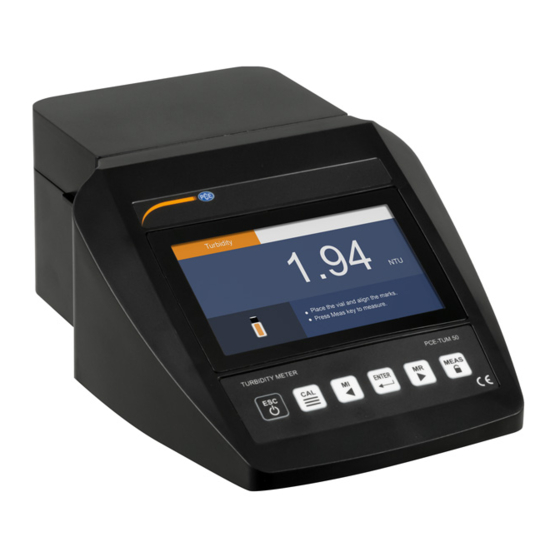
Table of Contents
Advertisement
Quick Links
Advertisement
Table of Contents

Summary of Contents for PCE Health and Fitness PCE-TUM 50
- Page 1 PCE-TUM 50 Turbidity Meter Instruction Manual...
- Page 2 Introduction Thank you for selecting the PCE-TUM 50 benchtop turbidity meter. This meter operates on the nephelometric principle of turbidity measurement and is designed to meet the criteria specified in ISO 7027. This manual provides a step-by-step guide to help you operate the meter, please carefully read the following instructions before use.
-
Page 3: Connecting The Power Adapter
Keypad The PCE-TUM 50 turbidity meter is designed with a 6 key, names and symbols describe each function key controls. FUNCTION • Switches the meter ON/OFF. • Exits the calibration or setting and returns to measurement. • Starts calibration. • Enters the setup menu (Press and hold the key for 3 seconds). -
Page 4: Setup Menu
Setup Menu The PCE-TUM 50 turbidity meter contains an integrated setup menu that is used to customize the displayed option to meet measurement requirements. The following table describes the functions of the menu items. MENU OPTIONS DESCRIPTION DEFAULT Year-month-day, hour- Date and Time Set the current date and time. - Page 5 Setting the measurement mode and unit The PCE-TUM 50 turbidity meter is capable of selecting the 4 turbidity units, including the NTU, FNU, EBC and ASBC. If the Total Suspended Solids mode is selected, the measurement unit will switch to mg/L.
-
Page 6: Auto Power Off
Auto-power off The PCE-TUM 50 turbidity meter provides an Auto-Power Off function that can be set to 2 hours or Disable. When the option is enabled, if you do not press any key within the specified time period, the meter will automatically turn off. -
Page 7: Restore Factory Settings
Unlock or reset the password Press and hold the key for 3 seconds, the meter shows the “Password Protection” and waits for entering the correct digits. 6.2 Press the ◄ or ► key to enter the password, press the Enter key to confirm. - Page 8 Important Notes for Measurement and Calibration • To avoid errors from ambient light interference, DO NOT use the meter in bright sunlight. Always close the light shield lid during the measurement and calibration. • Glass vials and caps must be cleaned thoroughly with deionised water after each measurement. Minor residuals can cause errors. •...
-
Page 9: Turbidity Calibration
Turbidity Calibration • The PCE-TUM 50 turbidity meter is calibrated with Formazin Standards at the factory and does not require user calibration prior to use. • During the calibration process, do not shake or agitate the calibration standard violently to prevent air bubbles. -
Page 10: Turbidity Measurement
Turbidity Measurement An accurate turbidity measurement depends on good measurement techniques. Factors such as clean sample vials, positioning of vial in the sample chamber, covering the vial with the light shield lid, meter calibration, removal of bubbles, etc. For more information, please refer to page 7 “Important Notes for Measurement and Calibration”. - Page 11 Total Suspended Solids Measurement The PCE-TUM 50 turbidity meter contains the Total Suspended Solids measurement mode that need to enter the correct conversion factor prior to measurement. Calculating the TSS factor Rinse the filter disk with distilled water to remove any solids that may remain.
-
Page 12: Storing And Recalling Data
The measurement method is the same as the turbidity. Please refer to page 10 “Turbidity Measurement”. Storing and Recalling Data The PCE-TUM 50 turbidity meter is capable of storing and recalling up to 200 data sets. Storing readings into memory During the measurement process, press the key to store the reading into the memory. -
Page 13: Clearing The Memory
Clearing the memory When the memory is full, the meter will automatically show a reminder if the key is pressed. To delete all stored data, please follow the steps below. Press and hold the key for 3 seconds to enter the setup menu. Press the ◄... -
Page 14: Receiving Data
Communication PCE Instruments provides a Data Acquisition System that can be used to transfer data, receive the measuring values or import the data to Excel. You are https://www.pce-instruments.com/english/download-win_4.htm able to download this software from our official website at Before installation, ensure that Windows 7/8/10 operating system has been installed on your computer. -
Page 15: Specifications
Specifications Model PCE-TUM 50 Measurement Method ISO 7027 nephelometric method (90°) Measurement Range 0~2000 NTU/FNU, 0~500 EBC, 0~9999 ASBC, TSS range depends on conversion factor Resolution 0.01 (0~100 NTU), 0.1 (100~999 NTU), 1 (999~2000 NTU) Accuracy ±2% (0~500 NTU), ±3% (501~2000 NTU) Default Calibration Standards 0.02, 10.00, 200, 500, 1000, 1500, 2000 NTU or User-Defined... -
Page 16: Warranty
Match sample vials For the best accuracy and repeatability of turbidity measurement, using one indexed vial is best choice. If you need to use a few vials, match these vials are necessary. Repeat the steps above for each vial and record the measured values. Find the closest position of these vials measuring value and mark it.















Need help?
Do you have a question about the PCE-TUM 50 and is the answer not in the manual?
Questions and answers